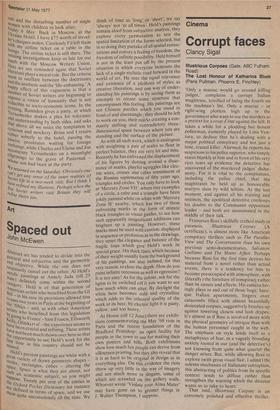Art
Spaced out
John McEwen
Abstract art has tended to divide into the gestural and subjective and the geometric and objective. While the one does not necessarily cancel out the other, Al Held's jacrYlic paintings at Annely Juda (till 25 cline) definitely come within the second AaLeg°rY. Held is of that generation of „erican artists who benefited from the GI tol" — in his case its provisions allowed him the two years in Paris at the beginning of artist' e 'fties — and, as with other American bs who benefited from this legislation KY g, °nig to France —Sam Francis, Ellsworth liL ellY, Olitski et al —the experience seems to n ,ave been crucial and refining. These artists thave not been much shown over here so that e0Pportunity to see Held's work for the lIrst Mtiissed.me in this country should not be Present paintings are white with a 6:,reat variety of drawn geometric shapes — `sneles, rectangles, cubes — altering the space. Space is what they are about, not suPueh an academic subject, so you might thellpse'TwentY .per cent of the entries in Oxford Pocket Dictionary for instance are defined in terms of space, and we use ern quite unconsciously all the time. We
think of time as 'long' or 'short', we say 'always' not 'at all times'. Held's paintings remain aloof from subjective analysis, they explore every permutation to test the spatial limitation of the forms selected, but in so doing they partake of all spatial connotations and convey a feeling of freedom, the freedom of infinite possibility. Held himself is not in the least put off by the present situation in which everyone bemoans the lack of a single stylistic road forward in the world of art. He sees the equal relevance and existence of a plethora of styles as creative liberation, and one way of understanding his paintings is by seeing them as attempts to create some structure that encompasses this feeling. His paintings are not Chinese puzzles which you stand in front of and disentangle; they should be left to work on you, their marks creating a constantly shifting and contradictory threedimensional space between where you are standing and the surface of the picture.
As with all such work, which is analogous with weighting a pair of scales to float in perfect balance, they are very hit and miss. Recently he has enlivened the displacement of his figures by dotting around a dissonance of marks, playful squiggles like electric wires, crosses and cubes reminiscent ot the Russian suprematists of fifty years ago, triangles and circles. You only have to look at 'Mercury Zone VII', where tiny examples of a circle, a cube and a triangle have been jokily painted white on white with 'Mercury Zone II' nearby, which has two of these enlivening marks in the form of minute black triangles as visual guides, to see how such apparently insignificant additions can brighten up a painting. However, these marks must be used with caution: displayed in sequence or profusion as in the drawings, they upset the elegance and balance of the fragile lines which give Held's work its special grace. His thick lines, which because of their weight usually form the background of his paintings, are also inclined, for that very reason, to close the depth. How do you paint infinite recession as well as egression? It is not easy! As for the colour, ask for the lights to be switched off it you want to see how much white can alter. By daylight the white here becomes cold and crystalline which adds to the ethereal quality of the work at its best; by electric light it is pasty, yellow, and too heavy.
At House (till 12 June) there are exhibitions commemorating the May '68 riots in Paris and the recent foundation of the Bradford Printshop: an open facility for people in the town to use for making their own posters and bills. Both exhibitions show how much fun people can derive from silkscreen printing, but they also reveal that it is as hard to be original in design as in everything else. On this evidence the riots threw up very little in the way of imagery and not much more in slogans, some of which are scrawled on the gallery walls. Whoever wrote 'Violate your Alma Mater' may have gone on to greater things in J. Walter Thompson, I suppose.


































 Previous page
Previous page